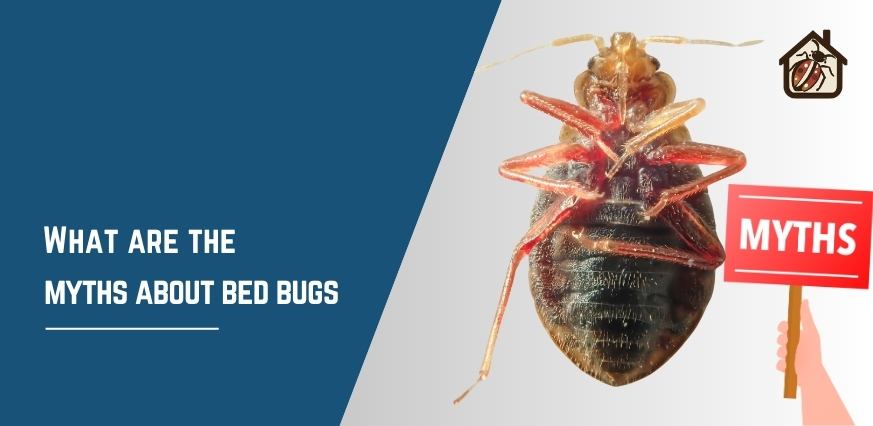
The little nocturnal animals known as bed bugs, which feed on human blood, have a reputation for spreading false information and causing terror. There are a lot of common myths about bed bugs that spread, creating false beliefs about their appearance, habits, and extinction. Together, we can dispel these myths and arm you with factual knowledge to effectively combat with bed bugs.
1. Myth: Bed bugs only inhabit dirty places.
It’s a frequent misperception that bed bugs may only be found in unclean or messy situations. Despite popular assumptions, bed bugs are drawn to blood, warmth, and carbon dioxide, not cleanliness. They can infiltrate any house, no matter how hygienic it is.
It is well known that bed bugs can easily spread through a variety of objects, such as used furniture, baggage, and other goods. For prevention and control to be effective, it is essential to realize that cleanliness is not a deterrent.
2. Myth: Bed bugs can fly or jump.
Bed bugs don’t have strong legs for jumping or wings for flight. They are skilled crawlers, reaching a startling top speed of almost one meter every minute, yet they are incapable of flying or jumping. Rather, bed bugs depend on other modes of transportation.
They frequently travel by hitching rides on clothes, bags, and furniture, which emphasizes how crucial it is to be on the lookout for possible infection sources.
3. Myth: Bed bugs are invisible.
The notion that bed bugs are invisible has been disproven by the fact that adult insects can be seen with the naked eye. They have a reddish-brown color and are about the size of an apple seed. Nymphs, or young bed bugs, and eggs are not microscopic, despite their diminutive size.
It’s critical to search for indicators of their presence, such as shed skins, rust-colored stains on bedding, or live bugs concealed in box springs and mattress seams. Even though bed bugs are good at hiding, they can be seen when closely examined.
4. Myth: Bed bugs transmit diseases.
Although bed bugs can be uncomfortable when they bite, there is no proof that they spread disease to people. Although bed bugs can cause allergic reactions, swelling, and itching in certain people, there is no known danger of disease transmission from their bites.
Knowing this helps allay unfounded worries and concentrate on dealing with the immediate problems associated with infestations without raising undue health concerns.
5. Myth: Bed bugs only come out at night.
Even though bed bugs usually only bite at night, it’s vital to understand that they can sometimes be active during the day, particularly in response to disturbances or hunger. Bed bugs are not deterred by light alone, in contrast to many other nocturnal pests.
Comprehending their flexible behavioral patterns highlights the necessity of all-encompassing preventive and therapeutic approaches that tackle their daytime and nighttime activity cycles.
6. Myth: You can easily eliminate bed bugs with DIY methods.
Due to their exceptional resistance, bed bugs need to be treated professionally using a variety of techniques. Among other techniques, effective bed bug management includes the use of insecticides, steam washing, and encasements.
The fact that DIY projects frequently fail highlights how difficult it is to eradicate these pests. A comprehensive and long-lasting remedy requires professional intervention.
7. Myth: Discarding the mattress eliminates bed bugs.
Bed bugs aren’t just found in beds; they can also be found hiding in baseboards, furniture, gaps, and crevices. The idea that getting rid of a mattress by itself will get rid of the infestation ignores how many places they can hide. For bed bugs to be successfully eradicated, the entire living space must be treated thoroughly.
8. Myth: Bed bug bites always leave visible marks.
It is untrue to assume that everyone reacts visibly to bed bug bites. Individuals react differently to bed bug bites; others have delayed symptoms or no apparent welts at all.
The significance of a thorough inspection strategy is underscored by the possibility of missing infestations in people who do not show typical symptoms if the diagnosis is based just on visible bite marks.
9. Myth: Bed bugs are a public health issue only in major cities.
Bed bugs are a global concern, prevalent in both urban and rural areas. Dismissing them as exclusive to major cities is a misconception. The resurgence of bed bugs worldwide emphasizes the need for vigilance across different locations and communities.
Their ability to thrive in various environments challenges the notion that they are confined to densely populated urban centers.
You may also like:
- What is the best bed bug killer
- How much heat does it take to kill bed bugs
- Can you get rid of bed bugs without throwing everything away
FAQs
Are bed bugs invisible?
Do bed bugs only inhabit dirty places?
Can bed bugs fly or jump?
Do bed bugs transmit diseases?
Do bed bugs only come out at night?
Can DIY methods easily eliminate bed bugs?
Does discarding the mattress eliminate bed bugs?
Do bed bug bites always leave visible marks?
Conclusion
For bed bug infestations to be effectively prevented and treated, it is imperative to understand the realities underlying these beliefs. Get knowledgeable about these pests, learn the nuances of controlling them, and make sure your home is pest-free.


